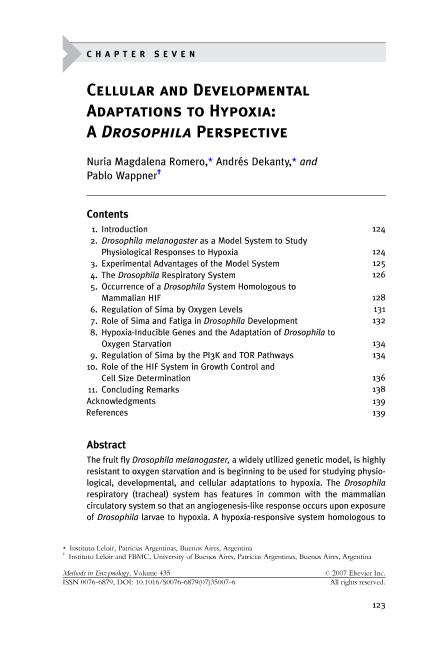Artículo
Cellular and developmental adaptations to hypoxia: a Drosophila perspective
Fecha de publicación:
12/2007
Editorial:
Elsevier Academic Press Inc
Revista:
Methods In Enzymology.
ISSN:
0076-6879
e-ISSN:
1557-7988
Idioma:
Inglés
Tipo de recurso:
Artículo publicado
Clasificación temática:
Resumen
The fruit fly Drosophila melanogaster, a widely utilized genetic model, is highly resistant to oxygen starvation and is beginning to be used for studying physiological, developmental, and cellular adaptations to hypoxia. The Drosophila respiratory (tracheal) system has features in common with the mammalian circulatory system so that an angiogenesis-like response occurs upon exposure of Drosophila larvae to hypoxia. A hypoxia-responsive system homologous to mammalian hypoxia-inducible factor (HIF) has been described in the fruit fly, where Fatiga is a Drosophila oxygen-dependent HIF prolyl hydroxylase, and the basic helix-loop-helix Per/ARNT/Sim (bHLH-PAS) proteins Sima and Tango are, respectively, the Drosophila homologues of mammalian HIF-alpha (alpha) and HIF-beta (beta). Tango is constitutively expressed regardless of oxygen tension and, like in mammalian cells, Sima is controlled at the level of protein degradation and subcellular localization. Sima is critically required for development in hypoxia, but, unlike mammalian model systems, it is dispensable for development in normoxia. In contrast, fatiga mutant alleles are all lethal; however, strikingly, viability to adulthood is restored in fatiga sima double mutants, although these double mutants are not entirely normal, suggesting that Fatiga has Sima-independent functions in fly development. Studies in cell culture and in vivo have revealed that Sima is activated by the insulin receptor (InR) and target-of-rapamycin (TOR) pathways. Paradoxically, Sima is a negative regulator of growth. This suggests that Sima is engaged in a negative feedback loop that limits growth upon stimulation of InR/TOR pathways
Palabras clave:
Hypoxia
,
Drosophila
,
Adaptation
,
Hif
Archivos asociados
Licencia
Identificadores
Colecciones
Articulos(IIBBA)
Articulos de INST.DE INVEST.BIOQUIMICAS DE BS.AS(I)
Articulos de INST.DE INVEST.BIOQUIMICAS DE BS.AS(I)
Citación
Wappner, Pablo; Dekanty, Andres; Romero, Nuria Magdalena; Cellular and developmental adaptations to hypoxia: a Drosophila perspective; Elsevier Academic Press Inc; Methods In Enzymology.; 435; 12-2007; 123-144
Compartir
Altmétricas




